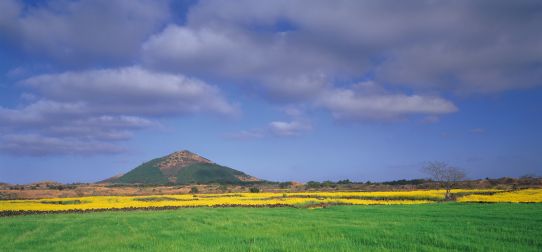Sharp Travel & Tours Inc.
Contact Info
Telephone - 847.759.8813
Toll Free - 1.888.To.Sharp
Email - sharptour@hotmail.com
Popular Destinations
STANDARD GROUP TOURS
DAILY EXCURSIONS
AMT RECOMMENDATIONS
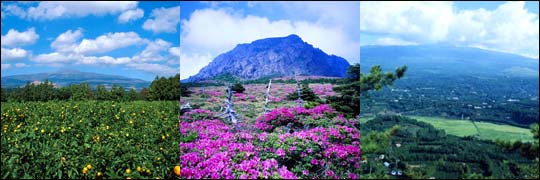
Hallasan, standing 1,950m above sea level as the highest mountain in South Korea, is a dormant volcano with a lake crater at its summit. The entire area has been designated as a nature preservation zone in an effort to protect the rare plants and animals that inhabit the mountain park. Every season at Hallasan presents a different and spectacular view, but it is most renown for its springtime beauty, when the azaleas are in full bloom.
Hallasan is located in the southernmost part of Korea, on Jeju Island. Clouds ring the summit, and snow covers its peaks during winter, bringing to mind a snowy kingdom. The first glimpse of a beautiful scarlet sun rising in the east can be caught from here, and the blazing sunsets are likewise spectacular. Folklore had it that a benevolent wizards existed on the mountain, and that they entertained themselves at the lake crater while riding on white deer. That is why the lake is called “Baekrokdam” (Hundred Deer Lake).
Hallasan is one of the 3 main mountains of Korea. The wide variety of plants and animals prompted its naming as Natural Monument No. 182-1 in October 1966, due to the high academic value of the various species, and it is now protected by law. It was designated a National Park in March 1970.
Jeju Folklore & Natural History Museum has currently on exhibition folklore remains and natural historical materials of Jeju-do that were excavated in Jeju-do and displayed in 1984. The museum is divided into 4 exhibition halls: the Natural History Hall, the Folklore Exhibition Hall Ⅰ, the Folklore Exhibition Hall Ⅱ, and the Outdoor Exhibition. The Natural History Exhibition Hall displays mainly natural historical items such as marine life, soil and rocks, and fauna and flora of Jeju in a three-dimensional way and gives visitors a better understanding of Jeju’s unique nature and culture. It is divided into an Ecology Hall of Marine Life, a Soil and Rock Exhibition Hall, and a Land Ecosystem Hall.

Hallim Park, located western 33km away from Jeju City and west of Mt. Hallasan along the beach in Hallimeup, is one of the most popular tourist spots on Jeju Island. It faces the pleasant scenery of Biyangdo Island, Hyeopjae Beach and Geumneung Beach. The park was established on barren land in Hyeopjaeri, Hallimeup, and covered with tons of earth and began planting assorted subtropical plants in early 1971.
Hallim Park, almost 100 thousand square meters, has a variety of gardens that can be enjoyed in any season. Visitors can enjoy checking out Palm Tree Road, Jeju Stone and Bonsai Garden, Water Garden, Subtropical Botanic Garden and much more. The most famous tourist sites in Hallim Park are Hyeopjaegul and Ssangyonggul Caves known to be the only two-dimensional caves in the world. In addition, a folk village, children's amusement park and outdoor resort facilities make it enjoyable for both children and adults.
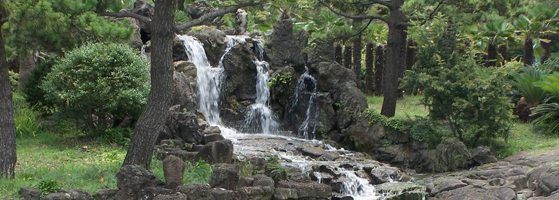
ANNUAL FESTIVALS
MT. HALLASAN NATIONAL PARK
FOLKLORE & NATURAL HISTORY MUSEUM
HALLIM PARK

JEJU ISLAND ATTRACTIONS
CHOENJEYEON WATERFALL
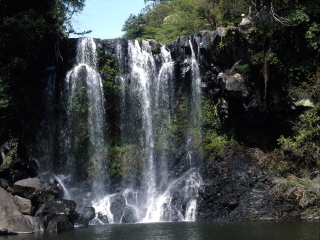
Cheonjeyeon Waterfall, named 'The pond of God', consists of 3 parts. Around the falls, there are rare plants such as ‘solipnan’ reeds. There is a cave in the east and from the ceiling cold water pours down creating the waterfall. The water from the first waterfall becomes the second and third waterfalls and flows into the sea. In Cheonjeyeon Valley, there is the “Seonimgyo Bridge”( Arch bridge that has 7 nymphs carved on the side) and the octagonal “Cheonjeru tower”. The Seonimgyo is also called “Chilseonyeogyo”(meaning seven nymphs) and it connects Cheonjeyeon with the Jungmum Tourist Complex.
SEONGEUP FOLK VILLAGE
Yongduam is a volcanic rock that was created from an eruption about two million years ago. It is 10 m high, and 30 m long. It is named so because of the legend that a dragon (“yong”) living in his dragon palace tried to ascend to the heavens and got stuck. Because the shape of the rock resembles the shape of the dragon’s head, it is called Yongduam. The rock now has only its body parts, because during a heavy storm a while ago, the head part of the rock was hit with lightening and fell off. About 200 meters to the east of Yongduam is Yongyeon (Dragon’s pond). Again, the pond is so named because it was said that the dragon used to play there. The water is so clean you can see the bottom of the pond.
YONGDUAM
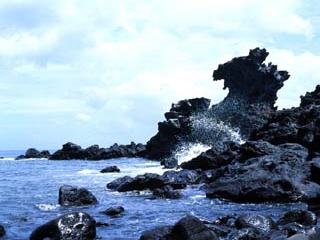

In the Folklore Exhibition Hall I, you will see a transformation in lifestyles of Jeju-do Island as well as Jeju people when you look at 2,381 display items. It also plays a very important role to visitors in helping them to understand the ancient life styles on Jeju Island by recapturing Jeju’s traditional housing architecture, rites of passage, and regional food specialties. The Folklore Exhibition Hall Ⅱ exhibits diving gear used by Haenye (women divers) and farming tools used by farmers in Jeju-do. In addition, 100 items including traditional tools for daily living, ritual materials, diverse stone structures made by volcanic rock of Jeju-do are exhibited in this outdoor exhibition.
On the surface of the Cheonjeru Tower, there is a painting that tells Cheonjeyeon’s legend of the nymph and mountain god. Every even-year in May, the Chilseonyeo Festival is held here.
Located at the foot of Mt. Halla, Seongeup Folk Village has perfectly preserved Korean tradition. With its vast amount of cultural property, this place is designated as a Folk Village. Many cultural properties such as residential houses, Confucian shrines and schools, ancient government offices, stone statues, millstones (run by horse or ox), fortress ruins, and stone monuments, and intangible cultural assets such as folk plays, native foods, local folk craftsmanship, and the local dialect are handed down to date. .
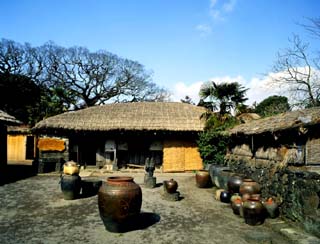
The several-hundred-year-old zelkova trees and nettle trees standing in the middle of the village are designated as natural monuments. Wandering around this area, you will feel as if you travled back to the past. It is a popular place for foreigners to experience the unique Korean native culture. Located on Jeju-do Island, Seongeup Folk Village shows the unique residential culture of the island; the poorly made windscreen stone wall (black lava rock), the straight but curvy Ollae (narrow alley) to block the wind, and the stone statues which have become the prime feature of the landscape. The local black-haired pigs and tongsi (pigsty / restroom) are especially well-known indigenous products. Pork is said to be very nutritious and the region, making the Folk Village a novel experience
POPULAR DESTINATIONS
© 2008 Sharp Travel and Tours Inc.
